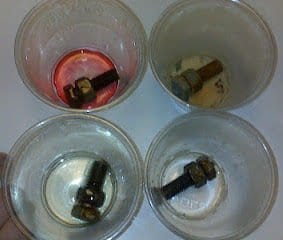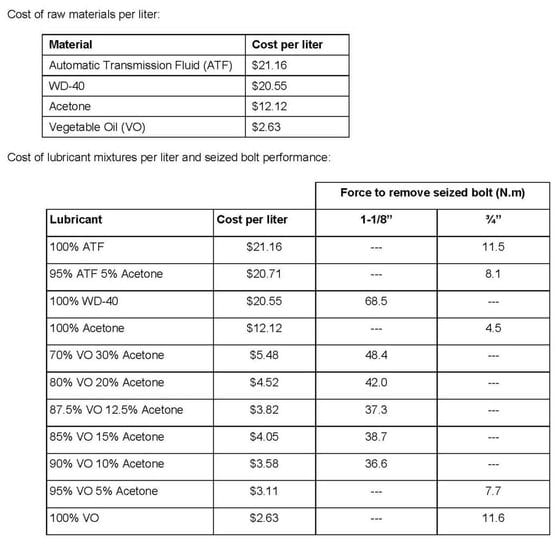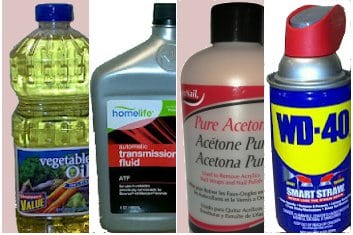 WD 40 lubricating spray may have some low-cost, do-it-yourself competition: vegetable oil and acetone. A mixture of vegetable oil with 10 percent acetone, the active ingredient in nail polish remover and some paint thinners, works as well to free rusted bolts as WD 40. And it costs about one-tenth of the price. Add more acetone, up to 30 percent, and the mixture works even better than WD 40 and still costs about one quarter the price of the commercial spray.
WD 40 lubricating spray may have some low-cost, do-it-yourself competition: vegetable oil and acetone. A mixture of vegetable oil with 10 percent acetone, the active ingredient in nail polish remover and some paint thinners, works as well to free rusted bolts as WD 40. And it costs about one-tenth of the price. Add more acetone, up to 30 percent, and the mixture works even better than WD 40 and still costs about one quarter the price of the commercial spray.
That’s good news for people in rural developing areas where commercial lubricating sprays can be expensive, and vegetable oils are easy to find and even possible to make.
Engineering students at Drexel University in Philadelphia, Penn., made the discovery. They conducted side-by-side comparison tests of vegetable oil mixtures, WD-40 and automatic transmission fluid.
The impetus for their research was a collaboration between two key E4C members: Pat Delany, who is proving to be an idea factory at E4C, had the idea, and Alex Moseson, a professor of engineering at Drexel who develops technologies appropriate for emerging economies.
Vegetable oil with 10% acetone performs as well as WD-40 to free seized bolts. And it costs about one- tenth of the price.
Delany is the creator of the low-cost screw-cutting lathe made from concrete and scrap metal. And Moseson has presided over the development of a seed planter for small-plot farmers and alkali-activated cement with a 97 percent smaller carbon footprint than the ordinary Portland variety, among other projects.
Moseson’s students tested Delany’s hunch that the vegetable mixture may work as well as the commercial spray, and they determined optimum formulas for performance and cost.
The test
The students placed 3/4” and 1-1/8” nuts and bolts in salt and sulfuric acid solutions for one week to rust. Then they applied penetrating oil mixtures and tested the bolts with a torque wrench.
Results

Table by Derek Maruca / Drexel University
Vegetable oil with five percent acetone works as wells as automatic transmission fluid with five percent acetone (used ATF is sometimes substituted for penetrating oil in resource-poor areas). Increasing the acetone content to 10 to 30 percent boosts the mixture’s performance. At that concentration, you can free the seized bolt using less than half of the force that it takes with WD-40.
The bottom line, Moseson tells E4C, is that vegetable oil with 10 percent acetone is more effective at freeing seized bolts than WD-40, it’s as effective as ATF and acetone, and it is more widely available in rural developing areas and kinder to the planet both in manufacture and disposal.
For details, please see the Drexel team’s final report. And here’s a cost and performance analysis by Derek Maruca, a Drexel student who put these tables together for E4C.
Related resources
Drexel team’s penetrating lubricant report (pdf)
How to make a seed planter (at Instructables)
DIY machine shop: Four essential tools you can build from recycled parts
A construction manual for an open source screw-cutting lathe


Interesting, but who uses WD-40 to free rusted bolts? I go to PB Blaster if something is so stuck that it feels like it will break. Works great. WD-40 is better for bicycle chains, gears, and cables, and for displacing water. So saying VO and acetone work as well as WD-40 isn’t saying much. Test it against PB Blaster and Liquid Wrench if you want to prove something.
Please tell me what the dashed lines in some of the boxes in your chart signifies. Do they mean that you didn’t try to loosen the fastener for some strange reason? or do they mean that you tried to loosen them and there was no RESISTANCE? or do they mean that you tried to loosen the fastener and and it could not be loosened? Thanks
Remind me not to go to Drexel. Is this why mechanics look at machines and wonder what the hell the engineer was thinking? This is inconclusive and uncontrolled. If you were to test these nut-bolt combinations to determine if there even was a consistent prevailing torque, I could give this some weight. WD has never been the standard for effective penetrating agents, it’s a passable temporary surface protectant and that’s about it, but if you’ve never turned a wrench in your life, and apparently that’s what passes for engineering students now, you use it like it was the gold standard. My Father and grandfather used Liquid Wrench, his father used kerosene, and I use PB Blaster for no other reason than it’s consistently available, as were the others. Penetrant wasn’t designed back when people did jobs with whatever was at hand to be easily replaceable in performance with less-expensive alternatives already at hand, it was designed to be worth the premium by working better, faster.
Thanks for this insight. I think what might be missing in this discussion is that this was a test of materials that are known to be available in developing countries in shops that might not be as well stocked as their developed-world counterparts. The kerosene that your great grandfather used would be worth studying, but you would have to weigh its utility against its cost, especially in places where kerosene is used regularly in cooking and lighting.
Although the article is good, I have to say that I don’t buy penetrating oil by the litre, which makes it a poor comparison. I have a small can of WD40 that I use, which is relatively cheap. It is more hassle and expense to get neat acetone outside of a lab (I spent over a quarter century in one) For something smaller, I would just boil it in oil for a while.
Not very useful, nor very well designed. You need to test all lubricants with all bolt sizes to have useful comparisons. All this test shows is (possibly) the optimal VO and acetone mix. But the ATF and acetone mix, which is a commonly used homemade penetrating oil, is not well represented. The normally used AFT and acetone mix is 50/50. This test would be of some use if various concentrations of AFT and acetone were used, again on all bold sizes.
Great information! I will try tomorrow.
Only thing I wonder(For practical purposes – mine.) is how long the penetrating oils were allowed to soak into the nuts/bolts, prior to removal?
For those who don’t spend much time at grocery or drug stores, vegetable oil and acetone are available at many, certainly the big ones, of either(Must be cheap, I bought some.). For acetone(Lots of reasons to have a bottle around.), look in the finger nail polish & removal section. Vegetable oil is often in baking needs aisle, or maybe condiments.
I have tried. Loctite, Plus Gas, Freeze, WD 40 , WD 40 SPecialist Blue Works, WD 40, Fast Release specialist , PB Blaster, BG In force, Bilt Hamber Ferrasol, Liquid Wrench, Kano, Lidil own brand, Aldi Own brand, Halfords, Shock Release, 3-in 1, Sea Foam Deep Creep, Wurth Rost Off, Wurth Rost off Ice, Normfest Ultra Crack, but the best is the home brew of 50:50 Acetone and ATF. I am sorry if I my spelling is a bit off, but the vapors of trying all these.
Lo ve your ideas